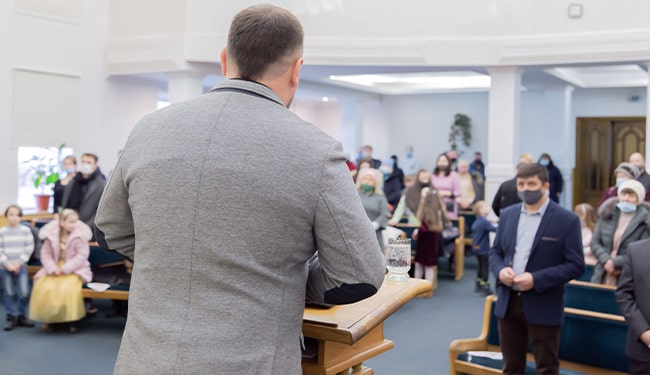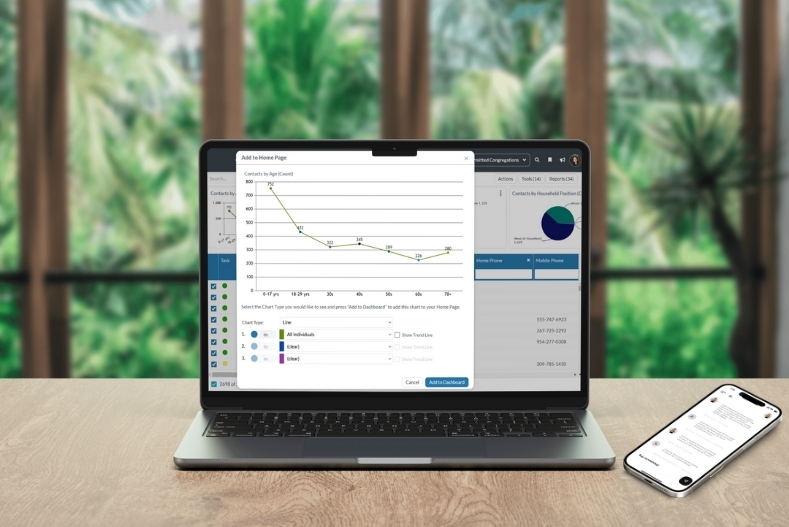For most of 2020, because of the COVID-19 pandemic, church leaders did the best they could to pivot their regular in-person worship services and other ministry activities to online experiences. Pastors and worship leaders did everything in their power to create connection with their parishioners. Some were able to do it well. Others struggled. But God was in everything they did and continued His work in and among His people.
As we all embrace 2021, with no end in sight for the online material requirement, it’s time to evaluate what mode of online material will best reach our church members and their spiritual and emotional needs. This may require additional investment in technology equipment and personnel who have the expertise needed to meet these needs in the best way possible.
In evaluating what might be most effective to minister to their people, church leaders should consider that live streaming might be better than using some kind of video conferencing platform or other pre-recorded replay of their service. There are benefits to making the financial and human investment to producing live streamed services that will help make the overall experience for parishioners more authentic and meaningful.
Here are some of the benefits of live streaming that will help you evaluate what might be best for your congregation in this new year.
Live Streaming vs. Video Conferencing or Pre-Recording
No commitment necessary. Video Conferencing requires worshipers to sign up ahead of time and be confirmed to attend. If they don’t join at the beginning of the event, they may be locked out completely. Live streaming only requires worshipers to go to the church website at the appointed service time and participate. If they are late or early, that is fine. If they need to leave early, that is OK, too. If they can’t make it, no one will know and there is no guilt factor to be applied (intentionally or unintentionally!).
No code or password to find or remember. When church members are seeking out a worshiping experience, they want it to be simple and easy to access. Live streaming offers that. They can click once and start participating in the service. Video conferencing platforms require passwords, links, and codes that can be challenging to find, remember, or access when people need them. Avoid any roadblocks that will keep people from making connections with your church. Easy access helps people join. Complicated access creates unnecessary disruptions.
Spend as much or as little time as you have. Live streaming allows people to come and go as their schedules permit. Despite events largely being cancelled due to the pandemic, people are still busy but are eager to fit worship services into their schedules as much as is possible. When you live-stream services they can “pop in” when they are able without having to arrive on time or stay until the end. They can come for the sermon or they can arrive just in time for the worship. Whatever their schedule allows, they can enjoy and participate.
Anonymity if Desired. Some people joining an online service are not yet ready to participate personally. Video conferencing platforms require people to present themselves and identify themselves to the group. This may be intimidating to some. Live-streaming the service allows churchgoers of all levels to come and go without notifying anyone that they’re online joining in the service. While church leaders want to know who is attending and pray that eventually everyone will willingly open up to church staff and other parishioners, the live stream format gives the gentle anonymity that some people desire.
Viewers feel like they’re actively participating. Some churches have been pre-recording services and playing them on Sunday at the regular worship service times. This has helped them to “get things right” which is a value to some churches without the technical capabilities to produce a live show. If at all possible, however, offering a live stream can help people who are watching from home feel more like they’re a part of the action, participating in what’s going on live in the church auditorium with all those who are attending in-person. For churches that are seeking to create connection, the church live stream services can help those at home feel connected to those who are sitting in the seats on campus.
While not possible for everyone, anyone who has the resources should consider live-streaming their services to create connection with their people and provide the much-needed interaction that church members need for their spiritual and emotional health in these unprecedented times. Make the investment today that will reap eternal benefits for tomorrow.





While Live Streaming may be more effective in most churches, in rural areas of our nation Internet service is iffy to none with no hope of Fiber Optics in the near future. As a result, the many rural churches–large and small–have no options for Live Streaming and make do with pre-recorded videos for worship.
If you have the means and method to assist churches in the areas where Internet access is iffy, your assistance would be greatly appreciated.
We have been live streaming from Day 1 (i.e., March 22, 2020), and the response has been very positive. It was rough at first, but it has evolved and improved. People say they feel like they’re really there. The one thing to add to the article is that live streams can be accessed after the event, so that people who were not able to attend at the appointed time could view the service after.
What about people who cannot participate in live stream because of work or other issues? Does Realm also record at the same time so service can be posted to website? We wish to be inclusive of those who cannot attend in person or at the time of service.
Most of this article is dedicated to benefits of livestream over ‘conference’ worships, using say, Zoom. I agree wholeheartedly. Conference programs were not made for this type of interaction.
However, the Livestream option also has many hiccups that aren’t directly offered as the double-edged sword they can still be- given that livestreams start at a particular time… anyone that cannot make that time in an existing schedule or a newly changed schedule (say because of a job change in the age of COVID), is now locked out of the ‘live’ worship, digital or in-person. Even someone that shows up 10 minutes late to a livestream may not have meant to show up late, and thus is ‘late’ to an experience that perhaps didn’t need to be locked to a particular time.
Additionally, Livestream technology is way more expensive and harder to manage well than is known by many outside of those who have tried to livestream well. Fiber internet, switches, cameras, software, subscriptions, and the process of managing livestream through additional staff is significant and often unthought of until midway through the setup process.
Prerecorded, however, has many positives and was largely unaddressed in either positive or negative in the article – it can go up at an earlier time, perhaps days earlier, to allow for more flexibility in when worship is experienced, and can be communicated and ‘published’ publicly at any point desired. Prerecorded has no issues streaming going outbound from the recorded location, taking out many of the issues that livestreams have, especially given higher traffic days like Easters or Palm Sundays, on platforms that can be overwhelmed. Many churches that offer ‘livestream’ services also actually are masquerading as livestream, when they are prerecorded, have an interactivity tool imbedded in the feed, and simply are only available at a designated time.
The drawback of prerecorded is the option to interact – 100% agree with that. However, to move to livestream to be able to directly interact, when there are ways to explore how to digitally interact with a prerecorded service (say by watch parties, outdoor settings where people gather, or using a ‘streaming’ interface via a dialogue box, commenting via YT, or the like), offers a good step for those who cannot invest the five or six figure/year investments of livestreaming well.
Our church has been alternating between live-streaming and pre-recording since September. The general consensus is that live-streaming is a more effective way to reach our congregation, but for a reason which this article has ignored. The reason is that, at least when broadcast over the church’s website, it is automatically saved and can be viewed at a later time. We have found that this feature appeals to a majority of our congregants, and has even gotten us several viewers who are not members. I would also like to point out that when we post our pre-recorded services to YouTube there is no need for any passwords. Just type in “Falkner Swamp” and our past pre-recorded services appear.